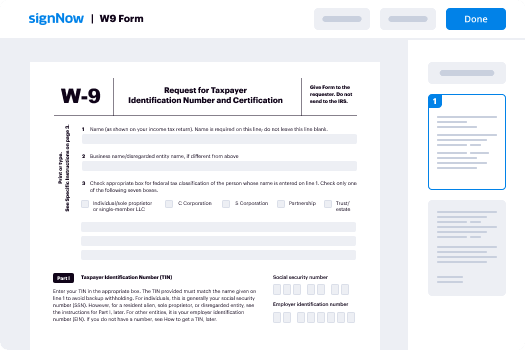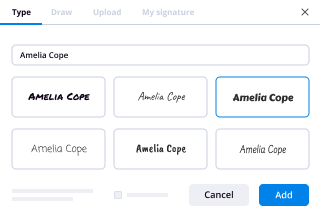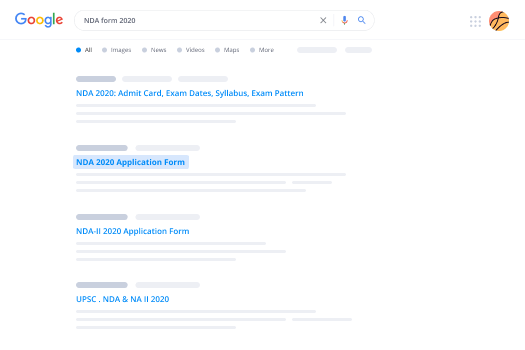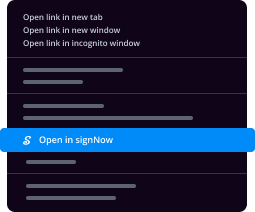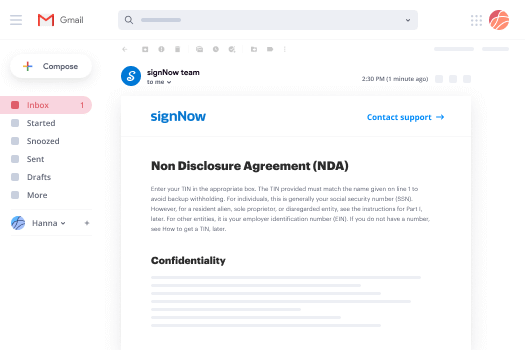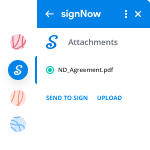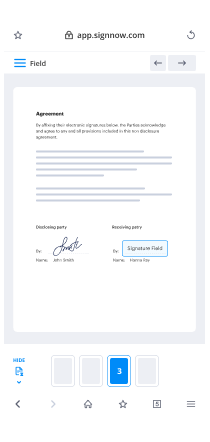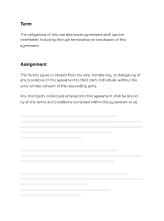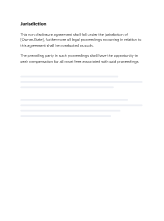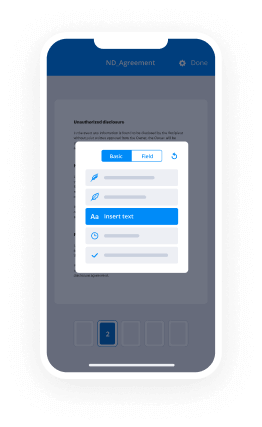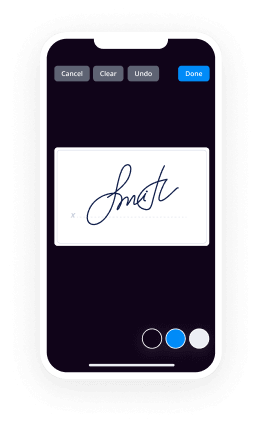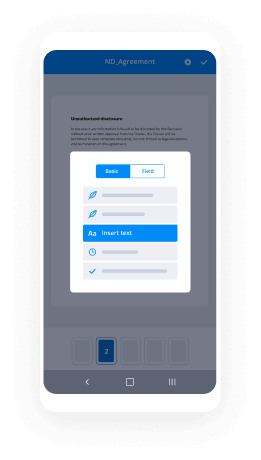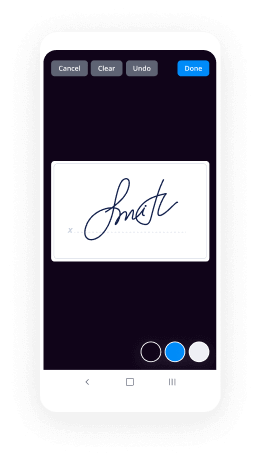Explorar Firma En Línea: Qué Constituye Una Firma Electrónica
- Rápido para iniciar
- Fácil de usar
- Soporte 24/7
Las empresas con visión de futuro de todo el mundo confían en SignNow






Guía rápida: qué constituye una firma electrónica
airSlate SignNow eSignature es una solución robusta para simplificar la recopilación de datos, la aprobación de contratos, la cooperación interna y externa, y agilizar los procedimientos de toma de decisiones. Firmar documentos electrónicamente es simple para equipos, socios y clientes, y ayuda a su negocio a eliminar el desperdicio de papel y el gasto innecesario.
Siga los pasos que se enumeran a continuación y descubra qué constituye una firma electrónica:
- Abra su navegador y visite signnow.com.
- Regístrese para una prueba gratuita o inicie sesión utilizando su correo electrónico o credenciales de Google/Facebook.
- Seleccione Avatar de Usuario -> Mi Cuenta en la parte superior derecha de la página web.
- Personalice su Perfil de Usuario con su información personal y cambiando configuraciones.
- Haga y gestione su(s) Firma(s) Predeterminada(s).
- Regrese a la página del panel de control.
- Desplace el cursor sobre el botón Cargar y Crear y elija la opción adecuada.
- Haga clic en el botón Preparar y Enviar junto al nombre del documento.
- Escriba la dirección de correo electrónico y el nombre de todos los firmantes en la ventana emergente que se abre.
- Utilice el menú Comenzar a agregar campos para proceder a editar el archivo y firmarlo usted mismo.
- Haga clic en GUARDAR E INVITAR cuando haya terminado.
- Continúe personalizando su flujo de trabajo de eSignature utilizando funciones adicionales.
Qué constituye una firma electrónica es una excelente pregunta y una que airSlate SignNow responde. Verifique las características que usted y su equipo están buscando para deleitar a sus clientes y compañeros con una mejor manera de gestionar su negocio. ¡Firme su primer contrato hoy!
Cómo funciona
Califica tu experiencia
What is an electronic signature?
An electronic signature, often referred to as an eSignature, is a digital representation of a person's intent to agree to the contents of a document. It can take various forms, including a typed name, a scanned handwritten signature, or a unique digital code. In the United States, electronic signatures are legally recognized under the Electronic Signatures in Global and National Commerce (ESIGN) Act, which provides that eSignatures hold the same legal weight as traditional handwritten signatures.
Key elements of an electronic signature
To be considered valid, an electronic signature must meet certain criteria:
- Intent to sign: The signer must demonstrate a clear intention to sign the document.
- Consent to use electronic signatures: All parties involved must agree to conduct the transaction electronically.
- Association with the record: The eSignature must be linked to the document in a way that proves the signer's identity.
- Record retention: The signed document must be stored securely and remain accessible for future reference.
Steps to complete an electronic signature
Completing an electronic signature using airSlate SignNow is a straightforward process:
- Upload the document: Start by uploading the document you need to sign.
- Fill out the form: Use airSlate SignNow's tools to fill in any required fields within the document.
- Request signatures: If others need to sign, you can easily send the document to them for their eSignature.
- Sign the document: Add your eSignature by selecting your preferred signing method.
- Complete and store: Once all signatures are collected, the document is finalized and securely stored.
Legal use of electronic signatures
In the U.S., electronic signatures are governed by federal and state laws, ensuring their validity in most transactions. The ESIGN Act and the Uniform Electronic Transactions Act (UETA) establish that eSignatures are legally binding, provided that the signers have consented to use electronic means and the transaction does not fall under specific exclusions, such as wills or certain family law matters. Understanding these legal frameworks is essential for businesses and individuals using eSignatures.
Security & Compliance Guidelines
When using electronic signatures, it is crucial to adhere to security and compliance guidelines to protect sensitive information. Key practices include:
- Encryption: Ensure documents are encrypted during transmission and storage to safeguard against unauthorized access.
- Authentication: Use multi-factor authentication to verify the identity of signers.
- Audit trails: Maintain detailed logs of the signing process, including timestamps and IP addresses, to provide a clear record of the transaction.
Examples of using an electronic signature
Electronic signatures can be utilized in various scenarios, such as:
- Contracts: Businesses can streamline contract signing processes, reducing turnaround time.
- HR documents: Employee onboarding forms and policy acknowledgments can be signed electronically.
- Real estate transactions: Buyers and sellers can sign agreements without needing to meet in person.
¡Obtenga ahora firmas vinculantes desde el punto de vista jurídico!
-
Mejor ROI. Nuestros clientes logran un promedio de 7x ROI en los primeros seis meses.
-
Se adapta a sus casos de uso. De las PYMES al mercado medio, airSlate SignNow ofrece resultados para empresas de todos los tamaños.
-
Interfaz de usuario intuitiva y API. Firma y envía documentos desde tus aplicaciones en minutos.
Firma en línea FAQs
-
What constitutes an electronic signature in airSlate SignNow?
An electronic signature in airSlate SignNow is defined as any electronic sound, symbol, or process that is attached to or logically associated with a document. It serves as a means of verifying the signer's intent to agree to the contents of the document. Understanding what constitutes an electronic signature is crucial for ensuring compliance and security in your transactions. -
How does airSlate SignNow ensure the legality of electronic signatures?
airSlate SignNow complies with various electronic signature laws, including the ESIGN Act and UETA, which outline what constitutes an electronic signature. By adhering to these regulations, airSlate SignNow ensures that your electronic signatures are legally binding and enforceable. This compliance provides peace of mind for businesses and individuals alike. -
What features does airSlate SignNow offer for electronic signatures?
airSlate SignNow offers a range of features that enhance the electronic signature process, including customizable templates, real-time tracking, and secure storage. These features streamline the signing process and ensure that what constitutes an electronic signature is clear and efficient. Users can easily manage documents and signatures from any device. -
Are there any costs associated with using airSlate SignNow for electronic signatures?
Yes, airSlate SignNow offers various pricing plans to accommodate different business needs. Each plan includes features that support what constitutes an electronic signature, ensuring you have the tools necessary for effective document management. You can choose a plan that fits your budget while still benefiting from a robust eSignature solution. -
Can airSlate SignNow integrate with other software?
Absolutely! airSlate SignNow integrates seamlessly with various applications, including CRM systems, cloud storage, and productivity tools. These integrations enhance the functionality of what constitutes an electronic signature by allowing users to manage documents across platforms efficiently. This connectivity helps streamline workflows and improve productivity. -
What are the benefits of using airSlate SignNow for electronic signatures?
Using airSlate SignNow for electronic signatures offers numerous benefits, including increased efficiency, reduced paper usage, and enhanced security. Understanding what constitutes an electronic signature helps businesses save time and resources while ensuring compliance. Additionally, the user-friendly interface makes it easy for anyone to adopt electronic signatures. -
Is airSlate SignNow secure for electronic signatures?
Yes, airSlate SignNow prioritizes security by employing advanced encryption and authentication methods. This ensures that what constitutes an electronic signature is protected from unauthorized access and tampering. Users can trust that their documents and signatures are safe throughout the signing process.




















